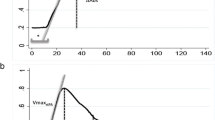Abstract
The plasma concentration of prothrombin fragment 1+2 (F1+2) is considered a very sensitive parameter for specific detection of latent hypercoagulability. To evaluate the degree of hypercoagulation associated with chronic uremia, we measured F1+2 by ELISA in the plasma of 51 patients with severe or end-stage chronic renal failure (35 males, 16 females, aged 22–81 years): 24 on dietary treatment, 15 on combined dietary and once a week hemodialysis, and 12 on regular maintenance hemodialysis; 33 healthy subjects served as a control group. Plasma F1+2 showed a significant elevation in the group on dietary treatment; it was further increased in the group on once a week hemodialysis, and even more markedly increased in the group on maintenance hemodialysis. In patients on dietary treatment a positive correlation was found between plasma F1+2 and serum creatinine. In patients on maintenance hemodialysis, no increase in the F1+2 plasma level was found during the course of a single hemodialysis session. Low molecular weight heparin, administered to 7 patients on dietary treatment, caused a marked drop in the F1+2 plasma level, providing evidence that the elevation in F1+2 indicates an accelerated in vivo thrombin generation rather than impaired renal catabolism. The enhanced coagulation activation appears to be related to the reduction of residual renal function, i.e., to the severity of renal failure, and may contribute to the increased risk of vascular events in uremic patients.
Similar content being viewed by others
References
Larsson SO. On coagulation and fibrinolysis in uremic patients on maintenance hemodialysis, Acta Med Scand 1971; 189:453.
Panicucci F, Sagripanti A, Pinori E, Vispi M, Lecchini L, Barsotti G, Giovannetti S. Comprehensive study of haemostasis in chronic uraemia. Nephron 1983; 33:5.
Turney JH, Woods HF, Fewell MR, Weston MJ. Factor VIII complex in uraemia and effects of haemodialysis. BMJ 1981; 282:1653.
Tomura S, Nakamura Y, Deguchi F, Chida Y, Ohno Y, Kodama S, Hayashi T, Suzuki K, Marumo F. Plasma Von Willebrand factor and thrombomodulin as markers of vascular disorders in patients undergoing regular hemodialysis therapy. Thromb Res 1990; 58:413.
Vaziri ND, Shah GM, Winer RL, Gonzales E, Patel B, Alikhani S, Nguyen QX, Yamamoto J. Coagulation cascade, fibrinolytic system, antithrombin III, protein C and protein S in patients maintained on continuous ambulatory peritoneal dialysis. Thromb Res 1989; 53:173.
Sagripanti A, Barsotti G. Bleeding and thrombosis in chronic uremia. Nephron. In press.
Tomura S, Nakamura Y, Deguchi F, Ando R, Chida Y, Marumo F. Coagulation and fibrinolysis in patients with chronic renal failure undergoing conservative treatment. Thromb Res 1991; 64:81.
Sorensen PJ, Knudsen F, Nielsen AH, Dyerberg J. Protein C assays in uremia. Thromb Res 1989; 54:301.
Faioni EM, Franchi F, Krachmalnicoff A, Valsecchi C, ViganÒ GL, Remuzzi G, Mannucci PM. Low levels of the anticoagulant activity of protein C in patients with chronic renal insufficiency: an inhibitor of protein C is present in uremic plasma. Thromb Haemost 1991; 66:420.
Lai K, Yin JA, Yuen PMP, Li PKT. Effect of hemodialysis on protein C, protein S and antithrombin levels. Am J Kidney Dis 1991; 17:38.
Sagripanti A, Cupisti A, Baicchi U, Ferdeghini M, Morelli E, Barsotti G. Plasma parameters of the prothrombotic state in chronic uremia. Nephron 1993; 62:273.
Bauer KA, Rosenberg RD. The pathophysiology of the prethrombotic state in humans: insight gained from studies using markers of hemostatic system activation. Blood 1987; 70:343.
Pelzer H, Schwarz A, Stüber W. Determination of human prothrombin activation fragment 1+2 in plasma with an antibody against a synthetic peptide. Thromb Haemost 1991; 65:153.
Bruhn H, Conard J, Mannucci M, Monteagudo J, Pelzer H, Reverter JC, Samama M, Tripodi A, Wagner C. Multicentric evaluation of a new assay for prothrombin fragment 1+ 2 determination. Thromb Haemost 1992; 68:413.
Lindner A, Charra B, Sherrad DJ, Scribner BH. Accelerated atherosclerosis in prolonged maintenance hemodialysis. N Engl J Med 1974; 290:697.
Morelli E, Baldi R, Barsotti G, Ciardella F, Cupisti A, Dani L, Mantovanelli A, Giovannetti S. Combined therapy for selected chronic uremic patients:infrequent hemodialysis and nutritional management. Nephron 1987; 47:161.
Mannucci PM, Tripodi A, Bottazzo B, et al. Markers of procoagulant imbalance in patients with inherited thrombophilic syndromes. Thromb Haemost 1992; 67:200.
Estivals M, Pelzer H, Sie P, et al. Prothrombin fragment 1+2, thrombin-antithrombin III complexes and D-dimers in acute deep vein thrombosis: effects of heparin treatment. Br J Haematol 1991; 78:421.
Marongiu F, Sorano GG, Mameli G, et al. Thrombin activity and oral anticoagulant therapy: a further evaluation. Haemostasis 1990; 20:63.
Kario K, Matsuo T, Yamada T, Nakao K, Shimano C, Matsuo M. Factor VII hyperactivity in chronic dialysis patients. Thromb Res 1992; 67:105.
Weinstein MJ, Chute LE, Schmitt GW, Hamburger RH, Bauer KA, Troll JH, Janson P, Deykin D. Abnormal factor VIII coagulant antigen in patients with renal dysfunction and in those with disseminated intravascular coagulation. J Clin Invest 1985; 76:1406.
Erdem Y, Haznedaroglu IC, Kiraz S. Increased prothrombin fragment 1+2 concentrations in hemodialysis patients. Clin Nephrol 1996; 45:69.
Bauer KA, Weiss LM, Sparrow D, Vokonas PS, Rosenberg RD. Aging-associated changes in indices of thrombin generation and protein C activation in humans. J Clin Invest 1987; 80:1527.
Kario K, Matsuo T, Matsuo Miyako, Koide M, Yamada T, Nakamura S, Sakata T, Kato H, Miyata T. Marked increase of activated factor VII in uremic patients. Thromb Haemost 1995: 73:763.
Author information
Authors and Affiliations
Rights and permissions
About this article
Cite this article
Sagripanti, A., Cozza, V., Baicchi, U. et al. Increased thrombin generation in patients with chronic renal failure. Int J Clin Lab Res 27, 72–75 (1997). https://doi.org/10.1007/BF02827247
Received:
Accepted:
Issue Date:
DOI: https://doi.org/10.1007/BF02827247




